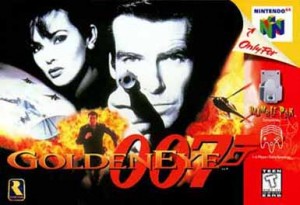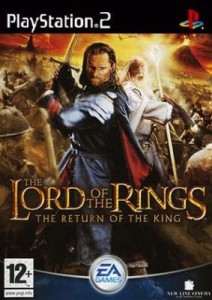In class today, Professor Mittell said “I want to play the video game of that movie,” and oftentimes, you can. Video game adaptations of movies are particularly popular (unsurprisingly) for large Hollywood “tentpoles” – those massive franchises studios market in all sorts of ways, action figures, pajamas, and of course, video games. But these movie-adaptation games exist as an interesting subset of video games at large, because they illustrate how a given narrative will be transformed as it movies across media. While I generally stay away from such games, I’d like to talk about two I have played: GoldenEye (Nintento 64) and Lord of the Rings: The Return of the King (PlayStation 2). Each illustrates a different way a video game can change a person’s experience with the narrative he or she plays versus the narrative he or she views.
GoldenEye 64 illustrates how a video game can alter a film’s narrative to make the protagonist the central force that drives all action. There are eighteen missions in the main game, eleven of which mirror Bond’s actions and objectives in the film. One (Silo) is blatantly superfluous and is in no way connected to the film or any of the other missions. But the remaining six are particularly interesting. In these missions, Bond participates in events that, though they occurred in the film, he had no original interaction with. For example, in the video game Bond travels to Severneya, infiltrates the bunker, and rescues Natalya just as the building explodes. In the original film however, Bond never went to Severneya and did not even know about it until after the fact. Natalya saved herself from the collapsing bunker, and had not even met Bond yet. Therefore in the video game adaptation of the story, Bond becomes the central catalyst for all narrative action.
The Return of the King illustrates another way video games adapt a story from cinema. In this game, the story is segmented into three distinct paths: Gandalf’s, Aragorn/Legolas/Gimli, and Sam/Frodo. After each completed mission, the player chooses which one he or she would like to tackle next, and can choose from any of the three paths. What is interesting here is that one can (although is not required to) experience the story of one set of characters straight through from start to finish. Whereas in the film (and Tolkien’s book, for that matter) told events sequentially and as such jumped from character to character, the video game allows the player the option of experiencing the story from the viewpoint of a character on their singular quest from start to finish. The game itself isn’t spectacular (and movie-adaptation games usually aren’t), but it does provide a fan with a new way of experiencing the story, which I think is reason enough to play it.

